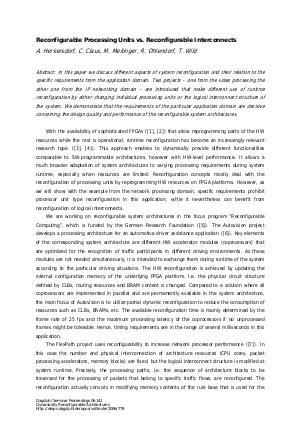Reconfigurable Processing Units vs. Reconfigurable Interconnects
Authors Andreas Herkersdorf, Christopher Claus, Michael Meitinger, Rainer Ohlendorf, Thomas Wild
-
Part of:
Volume:
Dagstuhl Seminar Proceedings, Volume 6141
Part of: Series: Dagstuhl Seminar Proceedings (DagSemProc) - License:
 Creative Commons Attribution 4.0 International license
Creative Commons Attribution 4.0 International license
- Publication Date: 2006-10-25
File

PDF
DagSemProc.06141.15.pdf
- Filesize: 34 kB
- 3 pages
Document Identifiers
Subject Classification
Keywords
- Reconfigurable SoC interconnect
Metrics
- Access Statistics
-
Total Accesses (updated on a weekly basis)
0Document
0Metadata
Abstract
The question we proposed to explore with the seminar participants is whether the dynamic reconfigurable computing community is paying sufficient attention to the subject of dynamic reconfigurable SoC interconnects. By SoC interconnect, we refer to architecture- or system-level building blocks such as on-chip buses, crossbars, add-drop rings or meshed NoCs. P Our motivation to systematically investigate this question originates from conceptual and architectural challenges in the FlexPath project. FlexPath is a new Network Processor architecture that flexibly maps networking functions onto both SW programmable CPU resources and (re-)configurable HW building blocks in a way that different packet flows are forwarded via different, optimized processing paths. Packets with well defined processing requirements may even bypass the central CPU complex (AutoRoute). In consequence, CPU processing resources are more effectively used and the overall NP throughput is improved compared to conventional NPU architectures. P The following requirements apply with respect to the dynamic adaptation of the processing paths: The rule basis for NPU-internal processing path lookup is updated in the order of 100us, packet inter-arrival time is in the order of 100ns. Partial reconfiguration of the rule basis (and/or interconnect structure) with state of the art techniques would take several ms resulting in a continuously blocked system. However, performing path selection with conventional lookup table search and updates (and a statically configured on-chip bus) takes considerably less than 100ns. Hence, is there a need for new conceptual approaches with respect to dynamic SoC interconnect reconfiguration, or is this a ''no issue'' as conventional techniques are sufficient?
Cite As Get BibTex
Andreas Herkersdorf, Christopher Claus, Michael Meitinger, Rainer Ohlendorf, and Thomas Wild. Reconfigurable Processing Units vs. Reconfigurable Interconnects. In Dynamically Reconfigurable Architectures. Dagstuhl Seminar Proceedings, Volume 6141, pp. 1-3, Schloss Dagstuhl – Leibniz-Zentrum für Informatik (2006)
https://doi.org/10.4230/DagSemProc.06141.15
BibTex
@InProceedings{herkersdorf_et_al:DagSemProc.06141.15,
author = {Herkersdorf, Andreas and Claus, Christopher and Meitinger, Michael and Ohlendorf, Rainer and Wild, Thomas},
title = {{Reconfigurable Processing Units vs. Reconfigurable Interconnects}},
booktitle = {Dynamically Reconfigurable Architectures},
pages = {1--3},
series = {Dagstuhl Seminar Proceedings (DagSemProc)},
ISSN = {1862-4405},
year = {2006},
volume = {6141},
editor = {Peter M. Athanas and J\"{u}rgen Becker and Gordon Brebner and J\"{u}rgen Teich},
publisher = {Schloss Dagstuhl -- Leibniz-Zentrum f{\"u}r Informatik},
address = {Dagstuhl, Germany},
URL = {https://drops.dagstuhl.de/entities/document/10.4230/DagSemProc.06141.15},
URN = {urn:nbn:de:0030-drops-7797},
doi = {10.4230/DagSemProc.06141.15},
annote = {Keywords: Reconfigurable SoC interconnect}
}
